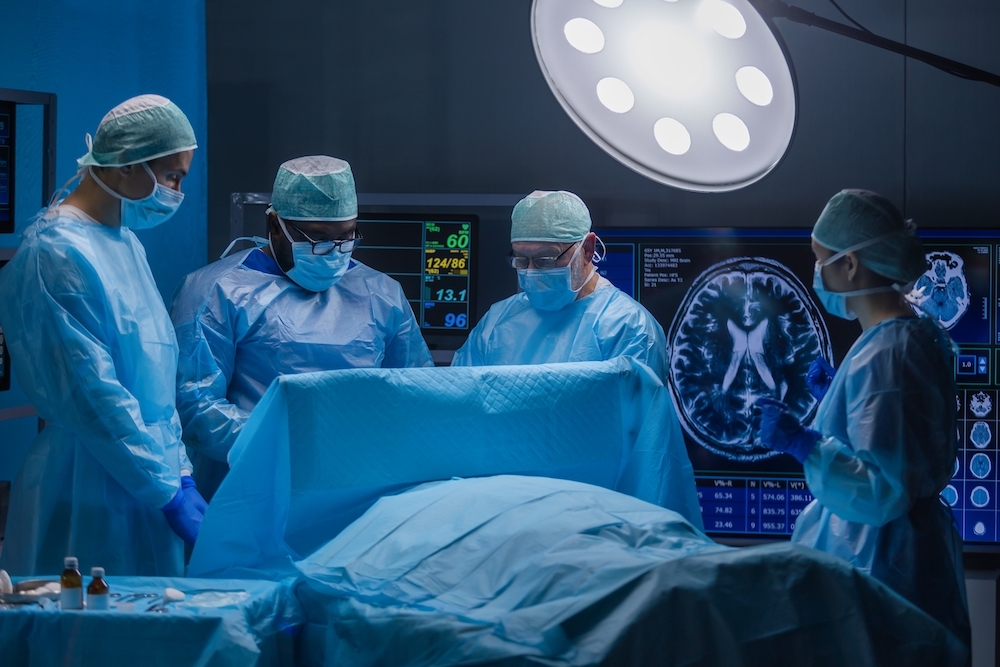A new study from Dr Gargi Banerjee, Prof John Collinge and colleagues at the UCL Institute of Prion Diseases has identified five cases of Alzheimer’s believed to have arisen from medical procedures performed decades earlier. The prospect of disease transmission between people is at first glance concerning, but what are the risks and how can they be mitigated?
Evidence grows for transmissible amyloid beta, but should we be concerned?

What was the challenge?
Until the mid-1980s, children with growth deficiencies were treated with a type of human growth hormone extracted from the pituitary glands of deceased individuals (cadaver-derived human growth hormone or c-hGH). This practice was stopped in 1985 when it was recognised that some c-hGH batches were contaminated with prions (infectious proteins) which had caused Creutzfeldt-Jakob disease (CJD) in some individuals. c-hGH was then replaced with synthetic growth hormone that did not carry the risk of transmitting CJD.
It was noted that some patients who developed CJD from this treatment (called iatrogenic CJD) also prematurely developed deposits of amyloid beta in their brains. This protein is heavily implicated in Alzheimer’s disease. When archived samples of c-hGH were then examined in 2018, some were shown to also be contaminated with amyloid beta and, despite having been stored for decades, transmitted amyloid beta pathology to laboratory mice when injected.
The researchers suggested that some individuals exposed to contaminated c-hGH, who did not succumb to the more rapidly progressing CJD and lived longer, might eventually develop Alzheimer’s disease.
What did the researchers do, and what did they find?
This newly published Nature Medicine study pursues this hypothesis, reporting on eight people referred to UCLH’s National Prion Clinic at the National Hospital for Neurology and Neurosurgery in London, who had all been treated with c-hGH in childhood but not developed CJD. Five of these people either had already been diagnosed with Alzheimer’s or would otherwise meet the diagnostic criteria for this condition; another person met criteria for mild cognitive impairment.
The unusually young age at which these patients developed symptoms, between 38-55, indicated to the authors that they did not have the usual sporadic Alzheimer’s which is associated with old age, and in the five patients in whom samples were available for genetic testing, the team also ruled out an inherited form of the disease.
The study authors therefore suggest that Alzheimer’s is potentially transmissible, and propose that, similar to CJD, the disease may have rare acquired forms, in addition to the known inherited and sporadic forms.
Is there a risk to the public?
The authors stress that first and foremost, as c-hGH treatment has not been used for decades, there is no risk of any new transmission via this route. There have also been no reported cases of Alzheimer’s acquired from any other medical or surgical procedures.
The lead author of the research, Prof John Collinge, Director of the UCL Institute of Prion Diseases and a consultant neurologist at UCLH, said:
“There is no suggestion whatsoever that Alzheimer’s disease can be transmitted between individuals during activities of daily life or routine medical care. The patients we have described were given a specific and long-discontinued medical treatment which involved injecting patients with material now known to have been contaminated with disease-related proteins.”
Prof Bart De Strooper, Group Leader at the UK DRI at UCL, who was not involved in the study, added:
“As the authors noted, based on current evidence, the risk of acquiring a transmissible form of amyloid is very low. No one should reconsider or forego any medical procedure, especially for blood transfusion or neurosurgery which saves many lives worldwide every year.”
In 2019, the UK DRI convened a roundtable on the subject of amyloid transmissibility and associated risk. These discussions resulted in a Lancet Neurology review outlining that although risk was very low, measures to mitigate this should be taken where appropriate. This included a call for increased vigilance and long-term monitoring, particularly following procedures in early life that involve human fluids or tissues.
Prof Bart De Strooper commented:
“Practical steps recommended include conducting larger epidemiological studies, continued investigation of risk using animal models, and the development of low cost, high-throughput sensitive tests for amyloid beta and other proteins to facilitate the precautionary sterilisation of, for example, neurosurgical instruments.”
Prof John Collinge and colleagues who were part of these discussions, echo this caution following findings from their new study:
“The recognition of transmission of amyloid-beta pathology in these rare situations should lead us to review measures to prevent accidental transmission via other medical or surgical procedures, in order to prevent such cases occurring in future.”
Researchers not involved in the study, including Prof Tara Spires-Jones, Group Leader at the UK DRI at Edinburgh, highlighted limitations of the study including a low sample size of eight cases. Prof Andrew Doig, Professor of Biochemistry and Programme Director for Biochemistry at the University of Manchester, noted that additional measures against risk may not be warranted as “we are already very careful about transmitting brain tissue between people, due to the small but real risk of passing on prions which might cause CJD.”
What is the impact of these findings on on our scientific understanding of Alzheimer's?
Although both Alzheimer’s and CJD are neurodegenerative diseases, many feel that the differences between them such as their slow v.s. fast progression rates, mean that mechanistic knowledge is not particularly transferrable between the conditions. The prospect of a rare, acquired form of Alzheimer’s, similar to CJD, may change that perspective.
The rare acquired or iatrogenic form of CJD represents fewer than 1% of all cases, perhaps contrary to public perception of the disease. Additionally, this transmissible form of CJD differs in clinical presentation, progression and neuropathological features from sporadic and inherited forms of the disease.
The authors suggest these characteristics are consistent with Alzheimer’s disease observed in the patients from this study as the occurrence would firstly, be extremely rare and, secondly, the symptoms and pathology shown were also atypical of spontaneous or inherited forms.
In the prion field, a major reason why forms of the disease manifest differently is due to strain types with differing structures of the protein. Early studies to examine various clinical subtypes of Alzheimer’s disease provide similar evidence that differing strains of amyloid beta play a key role in disease manifestation.
Although these investigations are in their early stages, the team at UCL Institute of Prion Diseases speculate that if prion-like mechanisms are driving Alzheimer’s disease, this would have a significant impact on therapeutic strategies.
References:
Article published: 29 January 2024
Banner image: shutterstock / Maksim Shmeljov

